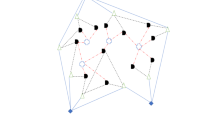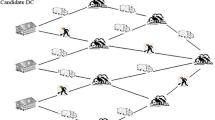Abstract
Every year natural and man-made disasters cause considerable human and economic losses. It is essential to prepare for different relief operations to prevent and reduce these losses. In this paper, we propose an integrated evacuation and distribution logistic system to obtain simultaneous routing and scheduling of vehicles to evacuate people from affected areas to shelters and provide them with necessary relief commodities. We assume that shelters and vehicles have limited capacity and the demand of each affected area and distribution center could be fulfilled by more than one vehicle (split delivery). The proposed problem is formulated as a Mixed-Integer Linear Programming model with the objective of minimization of the sum of arrival times of the vehicles at affected areas, shelters, and distribution centers. We also propose a Memetic Algorithm (MA) to solve this integrated model on large-scale problems efficiently after tuning the MA parameters using the Taguchi method. The proposed model and algorithm are used to solve a case study in Tehran, the capital of Iran. The evaluation of the results shows the effectiveness of the proposed disaster relief logistic system in minimizing the total waiting time of evacuees and delivery time of supplies. The results also show that the number of relief vehicles and capacity of shelters can considerably affect the total relief time in disaster relief operations.














Similar content being viewed by others
References
Abdelgawad, H., & Abdulhai, B. (2011). Large-scale evacuation using subway and bus transit: Approach and application in city of Toronto. Journal of Transportation Engineering,138, 1215–1232.
Abdelgawad, H., Abdulhai, B., & Wahba, M. (2010). Multiobjective optimization for multimodal evacuation. Transportation Research Record: Journal of the Transportation Research Board,2196, 21–33.
Ahmadi, M., Seifi, A., & Tootooni, B. (2015). A humanitarian logistics model for disaster relief operation considering network failure and standard relief time: A case study on San Francisco district. Transportation Research Part E: Logistics and Transportation Review,75, 145–163.
Alinaghian, M., & Naderipour, M. (2016). A novel comprehensive macroscopic model for time-dependent vehicle routing problem with multi-alternative graph to reduce fuel consumption: A case study. Computers & Industrial Engineering,99, 210–222.
Altay, N., & Green, W. G. (2006). OR/MS research in disaster operations management. European Journal of Operational Research,175, 475–493.
Banomyong, R., Varadejsatitwong, P., & Oloruntoba, R. (2017). A systematic review of humanitarian operations, humanitarian logistics and humanitarian supply chain performance literature 2005 to 2016. Annals of Operations Research. https://doi.org/10.1007/s10479-017-2549-5.
Bayram, V. (2016). Optimization models for large scale network evacuation planning and management: A literature review. Surveys in Operations Research and Management Science,21, 63–84.
Berkoune, D., Renaud, J., Rekik, M., & Ruiz, A. (2012). Transportation in disaster response operations. Socio-Economic Planning Sciences,46, 23–32.
Bish, D. R. (2011). Planning for a bus-based evacuation. OR Spectrum,33, 629–654.
Bozorgi-Amiri, A., Jabalameli, M., & Al-E-Hashem, S. M. (2013). A multi-objective robust stochastic programming model for disaster relief logistics under uncertainty. OR Spectrum,35, 905–933.
Bozorgi-Amiri, A., Jabalameli, M. S., Alinaghian, M., & Heydari, M. (2012). A modified particle swarm optimization for disaster relief logistics under uncertain environment. The International Journal of Advanced Manufacturing Technology,60, 357–371.
Bretschneider, S. (2012). Mathematical models for evacuation planning in urban areas. Berlin: Springer.
Burkart, C., Nolz, P. C., & Gutjahr, W. J. (2016). Modelling beneficiaries’ choice in disaster relief logistics. Annals of Operations Research,256(1), 41–61.
Cattaruzza, D., Absi, N., Feillet, D., & Vidal, T. (2014). A memetic algorithm for the multi trip vehicle routing problem. European Journal of Operational Research,236, 833–848.
Caunhye, A. M., Zhang, Y., Li, M., & Nie, X. (2016). A location-routing model for prepositioning and distributing emergency supplies. Transportation Research Part E: Logistics and Transportation Review,90, 161–176.
Coutinho-Rodrigues, J., Tralhão, L., & Alçada-Almeida, L. (2012). Solving a location-routing problem with a multiobjective approach: The design of urban evacuation plans. Journal of Transport Geography,22, 206–218.
Cross, R., & Crescent, R. (2011). The sphere handbook: Humanitarian charter and minimum standards in humanitarian response. The Sphere Project. http://www.sphereproject.org/handbook.
Dean, M. D., & Nair, S. K. (2014). Mass-casualty triage: Distribution of victims to multiple hospitals using the SAVE model. European Journal of Operational Research,238, 363–373.
Dror, M., Laporte, G., & Trudeau, P. (1994). Vehicle routing with split deliveries. Discrete Applied Mathematics,50, 239–254.
Dror, M., & Trudeau, P. (1989). Savings by split delivery routing. Transportation Science,23, 141–145.
Dror, M., & Trudeau, P. (1990). Split delivery routing. Naval Research Logistics (NRL),37, 383–402.
Gan, X., Wang, Y., Kuang, J., Yu, Y., & Niu, B. (2015). Emergency vehicle scheduling problem with time utility in disasters. Mathematical Problems in Engineering,2015, 1–7.
Gan, X., Wang, Y., Yu, Y., & Niu, B. (2013). An emergency vehicle scheduling problem with time utility based on particle swarm optimization. In Intelligent computing theories and technology. Springer.
Georgiadou, P. S., Papazoglou, I. A., Kiranoudis, C. T., & Markatos, N. C. (2010). Multi-objective evolutionary emergency response optimization for major accidents. Journal of Hazardous Materials,178, 792–803.
Goerigk, M., Deghdak, K., & Heßler, P. (2014). A comprehensive evacuation planning model and genetic solution algorithm. Transportation Research Part E: Logistics and Transportation Review,71, 82–97.
Goerigk, M., & Grün, B. (2014). A robust bus evacuation model with delayed scenario information. OR Spectrum,36, 923–948.
Hamedi, M., Haghani, A., & Yang, S. (2012). Reliable transportation of humanitarian supplies in disaster response: Model and heuristic. Procedia-Social and Behavioral Sciences,54, 1205–1219.
Hu, Z.-H., Sheu, J.-B., Yin, Y.-Q., & Wei, C. (2017). Post-disaster relief operations considering psychological costs of waiting for evacuation and relief resources. Transportmetrica A: Transport Science,13, 108–138.
Huang, X., & Song, L. (2016). An emergency logistics distribution routing model for unexpected events. Annals of Operations Research. https://doi.org/10.1007/s10479-016-2300-7.
Karaoglan, I., & Altiparmak, F. (2015). A memetic algorithm for the capacitated location-routing problem with mixed backhauls. Computers & Operations Research,55, 200–216.
Kelle, P., Schneider, H., & Yi, H. (2014). Decision alternatives between expected cost minimization and worst case scenario in emergency supply—Second revision. International Journal of Production Economics,157, 250–260.
Luis, E., Dolinskaya, I. S., & Smilowitz, K. R. (2012). Disaster relief routing: Integrating research and practice. Socio-economic Planning Sciences,46, 88–97.
Manopiniwes, W., & Irohara, T. (2015). Integrated relief supply distribution and evacuation: A stochastic approach. In Toward sustainable operations of supply chain and logistics systems. Springer.
Mokhtarinejad, M., Ahmadi, A., Karimi, B., & Rahmati, S. H. A. (2015). A novel learning based approach for a new integrated location-routing and scheduling problem within cross-docking considering direct shipment. Applied Soft Computing,34, 274–285.
Moshref-Javadi, M., & Lee, S. (2016a). The customer-centric, multi-commodity vehicle routing problem with split delivery. Expert Systems with Applications,56, 335–348.
Moshref-Javadi, M., & Lee, S. (2016b). The latency location-routing problem. European Journal of Operational Research,255, 604–619.
Naderi, B., Zandieh, M., & Fatemi Ghomi, S. (2009). Scheduling job shop problems with sequence-dependent setup times. International Journal of Production Research,47, 5959–5976.
Najafi, M., Eshghi, K., & De Leeuw, S. (2014). A dynamic dispatching and routing model to plan/re-plan logistics activities in response to an earthquake. OR Spectrum,36, 323–356.
Najafi, M., Eshghi, K., & Dullaert, W. (2013). A multi-objective robust optimization model for logistics planning in the earthquake response phase. Transportation Research Part E: Logistics and Transportation Review,49, 217–249.
Nolz, P. C., Semet, F., & Doerner, K. F. (2011). Risk approaches for delivering disaster relief supplies. OR Spectrum,33, 543–569.
Ozdamar, L. (2011). Planning helicopter logistics in disaster relief. OR Spectrum,33, 655–672.
Özdamar, L., Ekinci, E., & Küçükyazici, B. (2004). Emergency logistics planning in natural disasters. Annals of Operations Research,129, 217–245.
Pedraza-Martinez, A. J., & Van Wassenhove, L. N. (2012). Transportation and vehicle fleet management in humanitarian logistics: Challenges for future research. EURO Journal on Transportation and Logistics,1, 185–196.
Pelling, M., Maskrey, A., Ruiz, P., Hall, P., Peduzzi, P., Dao, Q.-H., et al. (2004). Reducing disaster risk: A challenge for development. New York: United Nations Development Programme.
Pourrahmani, E., Delavar, M. R., Pahlavani, P., & Mostafavi, M. A. (2015). Dynamic evacuation routing plan after an earthquake. Natural Hazards Review,16(4), 040150061-8.
Rath, S., & Gutjahr, W. J. (2014). A math-heuristic for the warehouse location–routing problem in disaster relief. Computers & Operations Research,42, 25–39.
Rennemo, S. J., Rø, K. F., Hvattum, L. M., & Tirado, G. (2014). A three-stage stochastic facility routing model for disaster response planning. Transportation Research Part E: Logistics and Transportation Review,62, 116–135.
Ruiz, R., & Stützle, T. (2007). A simple and effective iterated greedy algorithm for the permutation flowshop scheduling problem. European Journal of Operational Research,177, 2033–2049.
Saadatseresht, M., Mansourian, A., & Taleai, M. (2009). Evacuation planning using multiobjective evolutionary optimization approach. European Journal of Operational Research,198, 305–314.
Safaei, N., Saidi-Mehrabad, M., & Jabal-Ameli, M. (2008). A hybrid simulated annealing for solving an extended model of dynamic cellular manufacturing system. European Journal of Operational Research,185, 563–592.
Salehi, F., Mahootchi, M., & Husseini, S. M. M. (2017). Developing a robust stochastic model for designing a blood supply chain network in a crisis: A possible earthquake in Tehran. Annals of Operations Research. https://doi.org/10.1007/s10479-017-2533-0.
Sheu, J.-B., & Pan, C. (2014). A method for designing centralized emergency supply network to respond to large-scale natural disasters. Transportation Research Part B: Methodological,67, 284–305.
Taguchi, G. (1986). Introduction to quality engineering: Designing quality into products and processes. Tokyo: Asian Productivity Organization.
Talarico, L., Meisel, F., & Sörensen, K. (2015). Ambulance routing for disaster response with patient groups. Computers & Operations Research,56, 120–133.
Tzeng, G.-H., Cheng, H.-J., & Huang, T. D. (2007). Multi-objective optimal planning for designing relief delivery systems. Transportation Research Part E: Logistics and Transportation Review,43, 673–686.
Vahdani, B., Tavakkoli-Moghaddam, R., Zandieh, M., & Razmi, J. (2012). Vehicle routing scheduling using an enhanced hybrid optimization approach. Journal of Intelligent Manufacturing,23, 759–774.
Vásquez, Ó. C., Sepulveda, J. M., Alfaro, M. D., & Osorio-Valenzuela, L. (2013). Disaster response project scheduling problem: A resolution method based on a game-theoretical model. International Journal of Computers Communications & Control,8, 334–345.
Wex, F., Schryen, G., Feuerriegel, S., & Neumann, D. (2014). Emergency response in natural disaster management: Allocation and scheduling of rescue units. European Journal of Operational Research,235, 697–708.
Wohlgemuth, S., Oloruntoba, R., & Clausen, U. (2012). Dynamic vehicle routing with anticipation in disaster relief. Socio-economic Planning Sciences,46, 261–271.
Yi, W., & Kumar, A. (2007). Ant colony optimization for disaster relief operations. Transportation Research Part E: Logistics and Transportation Review,43, 660–672.
Yi, W., & Özdamar, L. (2007). A dynamic logistics coordination model for evacuation and support in disaster response activities. European Journal of Operational Research,179, 1177–1193.
Yu, Y., Chu, C., Chen, H., & Chu, F. (2012). Large scale stochastic inventory routing problems with split delivery and service level constraints. Annals of Operations Research,197, 135–158.
Yusoff, M., Ariffin, J., & Mohamed, A. (2008). Optimization approaches for macroscopic emergency evacuation planning: A survey. In International symposium on information technology, 2008. ITSim 2008 (pp. 1–7). IEEE.
Acknowledgements
The authors would like to thank the two anonymous referees for their constructive comments.
Author information
Authors and Affiliations
Corresponding author
Rights and permissions
About this article
Cite this article
Sabouhi, F., Bozorgi-Amiri, A., Moshref-Javadi, M. et al. An integrated routing and scheduling model for evacuation and commodity distribution in large-scale disaster relief operations: a case study. Ann Oper Res 283, 643–677 (2019). https://doi.org/10.1007/s10479-018-2807-1
Published:
Issue Date:
DOI: https://doi.org/10.1007/s10479-018-2807-1




